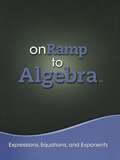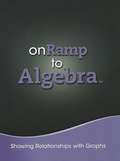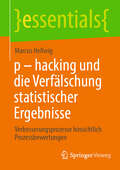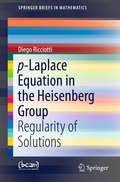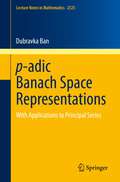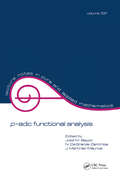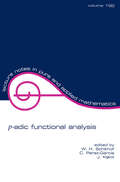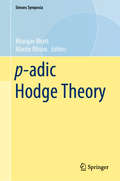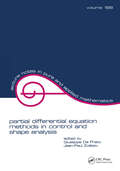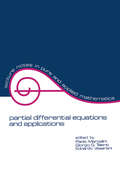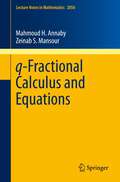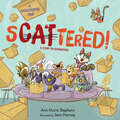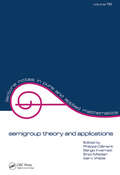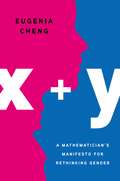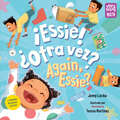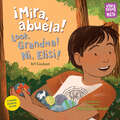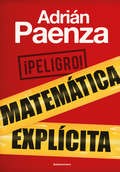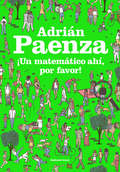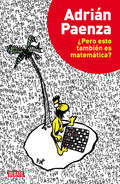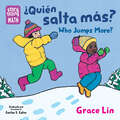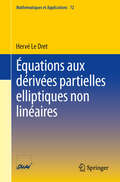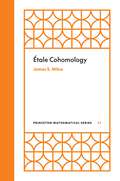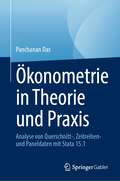- Table View
- List View
onRamp to Algebra: Expressions, Equations, and Exponents
by Prentice Hall Dictionary EditorsonRamp to Algebra is an intervention program designed exclusively to ensure that at-risk students are adequately prepared for Algebra 1. The program is ideally implemented the year prior, to build and solidify foundational skills and conceptual understanding necessary to be successful in Algebra 1. onRamp to Algebra is a complete instructional system that utilizes technology to deliver online homework support and in-class presentation screens for whole class participation. Although the program can be implemented solely with the printed Student and Teacher editions, it is optimized when coupled with in-class technology such as whiteboards/projectors; as well as when students access its online learning aids, which provide scaffolded, point-of-use homework support. As such, the program is designed to grow with your schools' Technology Plan. onRamp to Algebra is designed to be delivered in a single block class period. Each of the 112 lessons utilizes a classroom Workshop Model, designed to ensure that your formerly struggling students are constantly active, and engaged, participants throughout the entire 45-minute class. Built-in "Coach" supports (throughout the Teachers Edition), along with a Program Overview & Implementation Guide, and onsite and/or online Professional Development, ensure that all teachers are successful in the implementation of this program.
onRamp to Algebra: Foundations of Algebra
by Prentice HallonRamp to Algebra is an intervention program designed exclusively to ensure that at-risk students are adequately prepared for Algebra 1. The program is ideally implemented the year prior, to build and solidify foundational skills and conceptual understanding necessary to be successful in Algebra 1. onRamp to Algebra is a complete instructional system that utilizes technology to deliver online homework support and in-class presentation screens for whole class participation. Although the program can be implemented solely with the printed Student and Teacher editions, it is optimized when coupled with in-class technology such as whiteboards/projectors; as well as when students access its online learning aids, which provide scaffolded, point-of-use homework support. As such, the program is designed to grow with your schools' Technology Plan. onRamp to Algebra is designed to be delivered in a single block class period. Each of the 112 lessons utilizes a classroom Workshop Model, designed to ensure that your formerly struggling students are constantly active, and engaged, participants throughout the entire 45-minute class. Built-in "Coach" supports (throughout the Teachers Edition), along with a Program Overview & Implementation Guide, and onsite and/or online Professional Development, ensure that all teachers are successful in the implementation of this program.
onRamp to Algebra: Operations with Fractions (Student Edition) (Grades 7-9)
by Prentice HallonRamp to Algebra is an intervention program designed exclusively to ensure that at-risk students are adequately prepared for Algebra 1. The program is ideally implemented the year prior, to build and solidify foundational skills and conceptual understanding necessary to be successful in Algebra 1. onRamp to Algebra is a complete instructional system that utilizes technology to deliver online homework support and in-class presentation screens for whole class participation. Although the program can be implemented solely with the printed Student and Teacher editions, it is optimized when coupled with in-class technology such as whiteboards/projectors; as well as when students access its online learning aids, which provide scaffolded, point-of-use homework support. As such, the program is designed to grow with your schools' Technology Plan. onRamp to Algebra is designed to be delivered in a single block class period. Each of the 112 lessons utilizes a classroom Workshop Model, designed to ensure that your formerly struggling students are constantly active, and engaged, participants throughout the entire 45-minute class. Built-in "Coach" supports (throughout the Teachers Edition), along with a Program Overview & Implementation Guide, and onsite and/or online Professional Development, ensure that all teachers are successful in the implementation of this program.
onRamp to Algebra: Showing Relationships with Graphs (Student Edition) (Grades 7-9)
by Prentice HallonRamp to Algebra is an intervention program designed exclusively to ensure that at-risk students are adequately prepared for Algebra 1. The program is ideally implemented the year prior, to build and solidify foundational skills and conceptual understanding necessary to be successful in Algebra 1. onRamp to Algebra is a complete instructional system that utilizes technology to deliver online homework support and in-class presentation screens for whole class participation. Although the program can be implemented solely with the printed Student and Teacher editions, it is optimized when coupled with in-class technology such as whiteboards/projectors; as well as when students access its online learning aids, which provide scaffolded, point-of-use homework support. As such, the program is designed to grow with your schools' Technology Plan. onRamp to Algebra is designed to be delivered in a single block class period. Each of the 112 lessons utilizes a classroom Workshop Model, designed to ensure that your formerly struggling students are constantly active, and engaged, participants throughout the entire 45-minute class. Built-in "Coach" supports (throughout the Teachers Edition), along with a Program Overview & Implementation Guide, and onsite and/or online Professional Development, ensure that all teachers are successful in the implementation of this program.
p - hacking und die Verfälschung statistischer Ergebnisse: Verbesserungsprozesse hinsichtlich Prozessbewertungen (essentials)
by Marcus HellwigDie Signifikanz einer statistischen Aussage wird mit p bezeichnet, als probabilistische Größe. Es gibt Kritik an der Aussagekraft des p-Wertes dahin, dass er in der Statistik mitunter dahingehend missbraucht wird, dass Effektgrößen bewusst verfälscht werden. Dieser Missbrauch äußert sich darin, dass an der an der Größe und Auswahl einer Datenmenge solange manipuliert wird, bis die erwünschten Parameter erreicht werden. Diese Tätigkeit wird mit - p – hacking bezeichnet. Dieses essential widmet sich der Aufklärung.
p-Laplace Equation in the Heisenberg Group
by Diego RicciottiThis works focuses on regularity theory for solutions to the p-Laplace equation in the Heisenberg group. In particular, it presents detailed proofs of smoothness for solutions to the non-degenerate equation and of Lipschitz regularity for solutions to the degenerate one. An introductory chapter presents the basic properties of the Heisenberg group, making the coverage self-contained. The setting is the first Heisenberg group, helping to keep the notation simple and allow the reader to focus on the core of the theory and techniques in the field. Further, detailed proofs make the work accessible to students at the graduate level.
p-adic Banach Space Representations: With Applications to Principal Series (Lecture Notes in Mathematics #2325)
by Dubravka BanThis book systematically develops the theory of continuous representations on p-adic Banach spaces. Its purpose is to lay the foundations of the representation theory of reductive p-adic groups on p-adic Banach spaces, explain the duality theory of Schneider and Teitelbaum, and demonstrate its applications to continuous principal series. Written to be accessible to graduate students, the book gives a comprehensive introduction to the necessary tools, including Iwasawa algebras, p-adic measures and distributions, p-adic functional analysis, reductive groups, and smooth and algebraic representations. Part 1 culminates with the duality between Banach space representations and Iwasawa modules. This duality is applied in Part 2 for studying the intertwining operators and reducibility of the continuous principal series on p-adic Banach spaces.This monograph is intended to serve both as a reference book and as an introductory text for graduate students and researchers entering the area.
p-adic Function Analysis (Lecture Notes In Pure And Applied Mathematics Ser.)
by Jose M. Bayod"Written by accomplished and well-known researchers in the field, this unique volume discusses important research topics on p-adic functional analysis and closely related areas, provides an authoritative overview of the main investigative fronts where developments are expected in the future, and more. "
p-adic Functional Analysis
by W.H. Schikhof C. Perez-Garcia Jerzy Kakol"Contains research articles by nearly 40 leading mathematicians from North and South America, Europe, Africa, and Asia, presented at the Fourth International Conference on p-adic Functional Analysis held recently in Nijmegen, The Netherlands. Includes numerous new open problems documented with extensive comments and references."
p-adic Hodge Theory (Simons Symposia #210)
by Bhargav Bhatt Martin OlssonThis proceedings volume contains articles related to the research presented at the 2017 Simons Symposium on p-adic Hodge theory. This symposium was focused on recent developments in p-adic Hodge theory, especially those concerning integral questions and their connections to notions in algebraic topology. This volume features original research articles as well as articles that contain new research and survey some of these recent developments. It is the first of three volumes dedicated to p-adic Hodge theory.
partial differential equation methods in control and shape analysis: lecture notes in pure and applied mathematics (Lecture Notes in Pure and Applied Mathematics)
by Giuseppe Da Prato Jean-Paul Zolésio"Based on the International Federatiojn for Information Processing WG 7.2 Conference, held recently in Pisa, Italy. Provides recent results as well as entirely new material on control theory and shape analysis. Written by leading authorities from various desciplines."
partial differential equations and applications: Collected Papers in Honor of Carlo Pucci (Lecture Notes in Pure and Applied Mathematics #177)
by Paolo Marcellini Giorgio G. Talenti Edoardo VesentiniWritten as a tribute to the mathematician Carlo Pucci on the occasion of his 70th birthday, this is a collection of authoritative contributions from over 45 internationally acclaimed experts in the field of partial differential equations. Papers discuss a variety of topics such as problems where a partial differential equation is coupled with unfavourable boundary or initial conditions, and boundary value problems for partial differential equations of elliptic type.
q-Fractional Calculus and Equations
by Zeinab S. Mansour Mahmoud H. AnnabyThis nine-chapter monograph introduces a rigorous investigation of q-difference operators in standard and fractional settings. It starts with elementary calculus of q-differences and integration of Jackson's type before turning to q-difference equations. The existence and uniqueness theorems are derived using successive approximations, leading to systems of equations with retarded arguments. Regular q-Sturm-Liouville theory is also introduced; Green's function is constructed and the eigenfunction expansion theorem is given. The monograph also discusses some integral equations of Volterra and Abel type, as introductory material for the study of fractional q-calculi. Hence fractional q-calculi of the types Riemann-Liouville; Grünwald-Letnikov; Caputo; Erdélyi-Kober and Weyl are defined analytically. Fractional q-Leibniz rules with applications in q-series are also obtained with rigorous proofs of the formal results of Al-Salam-Verma, which remained unproved for decades. In working towards the investigation of q-fractional difference equations; families of q-Mittag-Leffler functions are defined and their properties are investigated, especially the q-Mellin-Barnes integral and Hankel contour integral representation of the q-Mittag-Leffler functions under consideration, the distribution, asymptotic and reality of their zeros, establishing q-counterparts of Wiman's results. Fractional q-difference equations are studied; existence and uniqueness theorems are given and classes of Cauchy-type problems are completely solved in terms of families of q-Mittag-Leffler functions. Among many q-analogs of classical results and concepts, q-Laplace, q-Mellin and q2-Fourier transforms are studied and their applications are investigated.
sCATtered!: A Story of Estimation (A Catastrophe Tale)
by Ann Marie StephensMath-loving kittens prepare a party for their number-one grandmother in this playful picture book that demonstrates the key math concept of estimation.The CATastrophe! cats are back, this time causing even more chaos! Nine kitties are purring with excitement for Grandma Cat&’s upcoming visit. They&’re going to throw her a party with cake, decorations, and a special gift. But when frantically cleaning cats misjudge how many toys they can hide in a closet, catastrophe looms. . . .Author Ann Marie Stephens draws upon more than 30 years of teaching experience to ensure that readers absorb math while having fun in the adventure-filled CATastrophe Tale series. And Jenn Harney&’s hilarious and energetic illustrations capture the antics of these enthusiastic kittens.Each book in the CATastrophe Tale series includes helpful back matter, which shows readers that, just like the kittens, they use mathematical skills in their everyday lives. Additional titles in the series include CATastrophe!: A Story of Patterns and CATawampus!: A Story of Shapes.
semigroup theory and applications
by Phillipe ClementThis book contains articles on maximal regulatory problems, interpolation spaces, multiplicative perturbations of generators, linear and nonlinear evolution equations, integrodifferential equations, dual semigroups, positive semigroups, applications to control theory, and boundary value problems.
x + y: A Mathematician's Manifesto for Rethinking Gender
by Eugenia ChengA brilliant mathematician examines the complexity of gender and society and forges a path out of inequality.Why are men in charge? After years in the male-dominated field of mathematics and in the female-dominated field of art, Eugenia Cheng has heard the question many times. In x + y, Cheng argues that her mathematical specialty -- category theory -- reveals why. Category theory deals more with context, relationships, and nuanced versions of equality than with intrinsic characteristics. Category theory also emphasizes dimensionality: much as a cube can cast a square or diamond shadow, depending on your perspective, so too do gender politics appear to change with how we examine them. Because society often rewards traits that it associates with males, such as competitiveness, we treat the problems those traits can create as male. But putting competitive women in charge will leave many unjust relationships in place. If we want real change, we need to transform the contexts in which we all exist, and not simply who we think we are.Praise for Eugenia Cheng"[Eugenia Cheng's] tone is clear, clever and friendly . . . she is rigorous and insightful. . . . [She is] a lucid and nimble expositor." --- Alex Bellos, New York Times Book Review "Dr. Cheng . . . has a knack for brushing aside conventions and edicts, like so many pie crumbs from a cutting board."--- Natalie Angier, New York Times
¡Essie! ¿Otra vez? / Again, Essie? (Storytelling Math)
by Jenny LacikaCelebrate diversity, math, and the power of storytelling! ¡Celebremos la diversidad, las matemáticas y el poder del cuento!Rafael wants to protect his toys from his little sister, Essie. Gathering materials from around the house, he builds a wall tall enough and wide enough to keep her out. But will it be strong enough? And what does Essie really want? A playful exploration of physical space and geometry, featuring Chicanx (Mexican American) characters and a glossary of Spanish words. Rafael quiere proteger sus juguetes de Essie, su hermanita. Para eso busca materiales en su casa para construir un muro que sea lo suficientemente alto y ancho como para que Essie no pase. ¿Pero ese muro será lo suficientemente fuerte? ¿Y qué quiere Essie realmente? Esta es una exploración divertida del espacio físico y de la geometría, la cual presenta personajes chicanos (mexicoamericanos) e incluye un glosario de palabras en español.Storytelling Math celebrates children using math in their daily adventures as they play, build, and discover the world around them. Joyful stories and hands-on activities make it easy for kids and their grown-ups to explore everyday math together. Developed in collaboration with math experts at STEM education nonprofit TERC, under a grant from the Heising-Simons Foundation. Los libros de la serie Cuentos matemáticos celebran las aventuras diarias de niños que usan las matemáticas mientras juegan, construyen y descubren el mundo que los rodea. Historias divertidas y actividades prácticas facilitan que tanto los niños como los adultos exploren juntos las matemáticas de la vida diaria. Fue desarrollada junto a expertos en el currículum STEM, pertenecientes a TERC Inc., organización sin fines de lucro, bajo una subvención otorgada por Heising-Simons Foundation.
¡Mira, abuela! / Look, Grandma! / Ni, Elisi! (Storytelling Math)
by Art Coulson¡Celebremos la diversidad, las matemáticas y el poder del cuento! Celebrating diversity, math, and the power of storytelling in Spanish bilingual editions!Bo quiere encontrar el recipiente perfecto para mostrar sus canicas tradicionales en la Fiesta Nacional Cheroqui. El recipiente debe tener el tamaño justo: lo suficientemente grande como para que quepan todas las canicas y lo suficientemente pequeño como para caber en el puesto de venta que su familia tendrá en el festival cheroqui. ¡Además debe ser bonito! Con la ayuda de su abuela, Bo encuentra lo que necesita. Este cuento es una exploración divertida sobre los conceptos de capacidad y volumen, que incluye personajes nativos americanos y un glosario de palabras cheroquis. La serie Storytelling Math (Cuentos Matemáticos) celebra el uso de las matemáticas en las aventuras diarias de niños y niñas, a medida que juegan, construyen y descubren el mundo que los rodea. La serie contiene historias divertidas y actividades para que niños y adultos compartan las matemáticas de la vida diaria. Fue desarrollada junto a expertos en el currículum STEM, pertenecientes a TERC Inc., organización sin fines de lucro, bajo una subvención otorgada por Heising-Simons Foundation. Bo wants to find the perfect container to show off his traditional marbles for the Cherokee National Holiday. It needs to be just the right size: big enough to fit all the marbles, but not too big to fit in his family's booth at the festival. And it needs to look good! A playful exploration of volume and capacity featuring Native characters and a glossary of Cherokee words.Storytelling Math celebrates children using math in their daily adventures as they play, build, and discover the world around them. Joyful stories and hands-on activities make it easy for kids and their grown-ups to explore everyday math together. Developed in collaboration with math experts at STEM education nonprofit TERC, under a grant from the Heising-Simons Foundation.
¡Peligro! Matemática explícita
by Adrián PaenzaUn verdadero festival de problemas, paradojas, dilemas e historias extraordinarias, conducido por el mejor divulgador de matemática del mundo. Cuenta Adrián que tiene la costumbre de guardar, en el bolsillo izquierdo de la camisa, papelitos con anotaciones sobre cosas que le suceden, que observa o le comentan, y que después esos apuntes se convierten en los problemas de sus libros. Es que la matemática está mucho más presente en la vida cotidiana de lo que parece, y si aprendemos a ver con un poco de curiosidad, se encuentra en todos lados. Desafíos en torno a una hamburguesa; cámaras que registran todos los movimientos de la pelota en un partido; cómo es el sorteo de las causas en los juzgados judiciales; decisiones de la inteligencia artificial; problemas sobre la verdad, la verosimilitud y la falsedad; Lennon o McCartney; Voltaire y el FMI; cómo repartir los bienes de una herencia; historias sobre bitcoins y blockchain; tatuajes increíbles; un museo muy inquietante, cómo cambiar reglas injustas y muchos más.
¡Un matemático ahí, por favor!
by Adrián PaenzaAunque no la veamos, la matemática está en todos lados y al alcance de quien quiera encontrarla. Adrián Paenza invita a descubrir cada uno de los rincones donde se esconde. Aunque no la veamos, la matemática está en todos lados y al alcance de quien quiera encontrarla. Cuando nos sacamos una selfie y al instante está guardada en la nube, cada vez que compramos un pasaje aéreo o incluso cuando cocinamos una torta. En este libro, Adrián Paenza invita a descubrir cada uno de los rincones donde se esconde la matemática en la vida cotidiana. Problemas donde el amor se mezcla con la tecnología, cómo deducir qué cartas eligieron Messi y Ronaldo, de qué modo darnos cuenta cuando alguien miente, por qué dos más dos puede sumar tres, cómo atrapar mil peces amarillos, un viaje de egresados muy particular y muchos desafíos más. Acróbatas y venenos, huevos y pollitos, Twitter y Snapchat, y los más extraordinarios problemas irresueltos de la historia. Porque no todo tiene una única solución.
¿Pero esto también es matemática?
by Adrián Paenza¡Todo es matemática! Máquinas tragaperras, claves secretas, laberintos, puentes flexibles y moscas que vuelan rápido como trenes. ¡Estamos rodeados de números! Fechas de nacimiento, números de documentos, id del ordenador, teléfonos... Números que repetimos automáticamente y comienzan a tener sentido cuando los asociamos y logramos pensar de forma distinta. En ese momento aprendemos a educar la intuición y encontramos soluciones inesperadas. Desde cómo mejorar el tráfico en una gran ciudad hasta cómo realizar menos pasos para montar un rompecabezas. Desde cómo elegir una clave bancaria segura hasta cómo encontrar la estrategia adecuada para no perder nunca a las damas o adivinar un número o una carta. La lógica matemática envuelve todos nuestros actos cotidianos y es mucho más divertida de lo que imaginábamos. Adrián Paenza nos invita a sumergirnos en el mundo de las matemáticas recreativas, de la matemagia. Un universo donde se aprende jugando.
¿Quién salta más? / Who Jumps More? (Storytelling Math)
by Grace Lin¡Libro de cartón grueso ahora disponible en español-inglés bilingüe! La ganadora del Honor de Caldecott, Grace Lin, celebra las matemáticas para todos los niños, ¡en todas partes!Board book now available in bilingual Spanish-English! Caldecott Honor winner Grace Lin celebrates math for every kid, everywhere!Olivia y Mei saltan en la nieve hasta llegar al árbol alto. Mei da unos saltos grandes como un reno. Olivia da muchos saltitos más pequeños como un conejo. Cada una salta "más" de manera diferente. Una exploración juguetona de la medición, la proporción y la amistad.Storytelling Math celebra a los niños usando las matemáticas en sus aventuras diarias mientras juegan, construyen y descubren el mundo que les rodea. Historias alegres y actividades manuales hacen que sea fácil para los niños y sus adultos explorar las matemáticas cotidianas juntos. Desarrollado en colaboración con expertos en matemáticas de TERC, una organización educativa con enfoque en ciencia, tecnología, ingeniería y matemáticas (STEM, por sus siglas en inglés), bajo una subvención de la Fundación Heising-Simons.Olivia and Mei jump in the snow all the way to the tall tree. Mei takes a few big leaps like a deer. Olivia makes lots of smaller hops like a bunny. Each jumps &“more&” in a different way. A playful exploration of measurement, proportion, and friendship.Storytelling Math celebrates children using math in their daily adventures as they play, build, and discover the world around them. Joyful stories and hands-on activities make it easy for kids and their grown-ups to explore everyday math together. Developed in collaboration with math experts at STEM education nonprofit TERC, under a grant from the Heising-Simons Foundation.
Équations aux dérivées partielles elliptiques non linéaires
by Herve Le DretCet ouvrage est issu d'un cours de Master 2 enseigné à l'UPMC entre 2004 et 2007. Nous y présentons une sélection de techniques mathématiques orientées vers la résolution des équations aux dérivées partielles elliptiques semi-linéaires et quasi-linéaires. Après un vade-mecum d'analyse réelle et d'analyse fonctionnelle de base pour les EDP, sans démonstrations pour les points les plus connus, nous parcourons ainsi les théorèmes de point fixe classiques, les opérateurs de superposition dans les espaces de Lebesgue et de Sobolev, la méthode de Galerkin, les principes du maximum et la régularité elliptique, nous faisons une excursion assez longue dans divers aspects du calcul des variations puis terminons par les opérateurs monotones et pseudo-monotones. Tout ceci est agrémenté d'exemples et chaque chapitre est complété d'un nombre d'exercices qui croît essentiellement avec le numéro du chapitre, au fur et à mesure que de nouveaux matériaux sont présentés. This book stems from lectures notes of a Master 2 class held at UPMC between 2004 and 2007. A selection of mathematical techniques geared towards the resolution of semilinear and quasilinear elliptic partial differential equations is presented. After a short survival guide in basic real and functional analysis for PDEs, without proofs for the most well-known results, we walk through the classical fixed point theorems, the superposition operators in Lebesgue and Sobolev spaces, the Galerkin method, the maximum principles and elliptic regularity, we make a rather long foray into various aspects of the calculus of variations, and conclude with monotone and pseudo-monotone operators, by way of numerous examples. Each chapter is complemented by a number of exercises that grows with the chapter number as more and more material is made available.
Étale Cohomology (Princeton Mathematical Series)
by James S. MilneAn authoritative introduction to the essential features of étale cohomologyA. Grothendieck&’s work on algebraic geometry is one of the most important mathematical achievements of the twentieth century. In the early 1960s, he and M. Artin introduced étale cohomology to extend the methods of sheaf-theoretic cohomology from complex varieties to more general schemes. This work found many applications, not only in algebraic geometry but also in several different branches of number theory and in the representation theory of finite and p-adic groups. In this classic book, James Milne provides an invaluable introduction to étale cohomology, covering the essential features of the theory.Milne begins with a review of the basic properties of flat and étale morphisms and the algebraic fundamental group. He then turns to the basic theory of étale sheaves and elementary étale cohomology, followed by an application of the cohomology to the study of the Brauer group. After a detailed analysis of the cohomology of curves and surfaces, Milne proves the fundamental theorems in étale cohomology—those of base change, purity, Poincaré duality, and the Lefschetz trace formula—and applies these theorems to show the rationality of some very general L-series.
Ökonometrie in Theorie und Praxis: Analyse von Querschnitt-, Zeitreihen- und Paneldaten mit Stata 15.1
by Panchanan DasDieses Buch führt in die ökonometrische Analyse von Querschnitts-, Zeitreihen- und Paneldaten unter Anwendung statistischer Software ein. Es dient als Grundlagentext für diejenigen, die ökonometrische Analysen in der empirischen Forschung erlernen und anwenden wollen. Das Niveau der Darstellung ist so einfach wie möglich gehalten, um es sowohl für Studenten im Grundstudium als auch für Doktoranden nützlich zu machen. Es enthält mehrere Beispiele mit realen Daten und Stata-Programmen sowie die Interpretation der Ergebnisse. Bei der Diskussion der statistischen Instrumente, die zum Verständnis der empirischen Wirtschaftsforschung erforderlich sind, versucht das Buch, ein Gleichgewicht zwischen Theorie und angewandter Forschung herzustellen. Verschiedene Konzepte und Techniken der ökonometrischen Analyse werden durch sorgfältig entwickelte Beispiele unter Verwendung des statistischen Softwarepakets Stata 15.1 unterstützt, wobei vorausgesetzt wird, dass der Leser mit der Software Strata einigermaßen vertraut ist.
